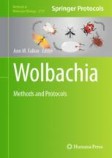Search
Search Results
-
Outcrossing rates in an experimentally admixed population of self-compatible and self-incompatible Arabidopsis lyrata
The transition to self-compatibility from self-incompatibility is often associated with high rates of self-fertilization, which can restrict gene...

-
Differential retention of transposable element-derived sequences in outcrossing Arabidopsis genomes
BackgroundTransposable elements (TEs) are genomic parasites with major impacts on host genome architecture and host adaptation. A proper evaluation...

-
Reproductive strategies and their consequences for divergence, gene flow, and genetic diversity in three taxa of Clarkia
Differences in reproductive strategies can have important implications for macro- and micro-evolutionary processes. We used a comparative approach...

-
Wolbachia Transinfection Via Embryonic Microinjection
The process of transferring Wolbachia from one species to another to establish a stable, maternally inherited infection in the target species is...
-
Evolution of Pathogenicity and Virulence
Evolutionary biologists define virulence as reduction in host fitness (survival and reproduction) caused by pathogens. The avirulence hypothesis...
-
Inheritance of distyly and homostyly in self-incompatible Primula forbesii
The evolutionary transition from self-incompatible distyly to self-compatible homostyly frequently occurs in heterostylous taxa. Although the...

-
More than meets the eye: syntopic and morphologically similar mangrove killifish species show different mating systems and patterns of genetic structure along the Brazilian coast
Different mating systems can strongly affect the extent of genetic diversity and population structure among species. Given the increased effects of...

-
Dissecting the sequential evolution of a selfish mitochondrial genome in Caenorhabditis elegans
Mitochondrial genomes exist in a nested hierarchy of populations where mitochondrial variants are subject to genetic drift and selection at each...

-
Widespread coexistence of self-compatible and self-incompatible phenotypes in a diallelic self-incompatibility system in Ligustrum vulgare (Oleaceae)
The breakdown of self-incompatibility (SI) in angiosperms is one of the most commonly observed evolutionary transitions. While multiple examples of...

-
Complex parental effects impact variation in larval thermal tolerance in a vertically transmitting coral
Coral populations must be able to adapt to changing environmental conditions for coral reefs to persist under climate change. The adaptive potential...

-
Agricultural Bioinformatics
Agricultural bioinformatics can play a very important role in improving crop productivity. The important areas of agricultural bioinformatics are...
-
Microsatellites reveal high polymorphism and high potential for use in anti-malarial efficacy studies in areas with different transmission intensities in mainland Tanzania
BackgroundTanzania is currently implementing therapeutic efficacy studies (TES) in areas of varying malaria transmission intensities as per the World...

-
Sibling competition does not magnify inbreeding depression in North American Arabidopsis lyrata
About half of all angiosperms have some form of molecular self-incompatibility to promote outcrossing. If self-incompatibility breaks down,...

-
Evaluating the performance of Plasmodium falciparum genetic metrics for inferring National Malaria Control Programme reported incidence in Senegal
BackgroundGenetic surveillance of the Plasmodium falciparum parasite shows great promise for hel** National Malaria Control Programmes (NMCPs)...

-
Fitness consequences of hybridization in a predominantly selfing species: insights into the role of dominance and epistatic incompatibilities
Studying the consequences of hybridization on plant performance is insightful to understand the adaptive potential of populations, notably at local...

-
Why we thrive beneath a northern sky – genomic signals of selection in apple for adaptation to northern Sweden
Good understanding of the genomic regions underlying adaptation of apple to boreal climates is needed to facilitate efficient breeding of locally...

-
Plant pangenomes for crop improvement, biodiversity and evolution
Plant genome sequences catalogue genes and the genetic elements that regulate their expression. Such inventories further research aims as diverse as...

-
Genetic analysis reveals unique characteristics of Plasmodium falciparum parasite populations in Haiti
BackgroundWith increasing interest in eliminating malaria from the Caribbean region, Haiti is one of the two countries on the island of Hispaniola...

-
Applications of CRISPR/Cas Beyond Simple Traits in Crops
Advancements in genome manipulation have transformed the whole face of synthetic biology. Technologies like CRISPR/Cas based gene editing offer...
-
Advances and opportunities in malaria population genomics
Almost 20 years have passed since the first reference genome assemblies were published for Plasmodium falciparum , the deadliest malaria parasite, and A...

